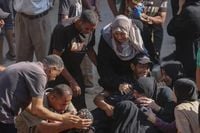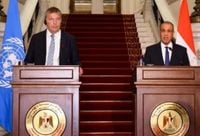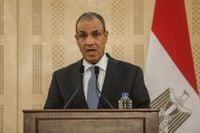As the sun set over the Mediterranean on September 6, 2025, the battered skyline of Gaza City was once again shrouded in smoke and uncertainty. The Israeli military, intensifying its nearly two-year campaign against Hamas, issued fresh evacuation orders and targeted high-rise buildings, urging Palestinians to flee south. But for most families, repeatedly displaced since the war erupted, the command felt like a cruel echo. “Where do I go? We went to the south, there is no space in the south, where can we go?” asked Nadia Marouf, a mother whose tent—her last refuge—was destroyed in a recent airstrike, according to The Associated Press.
The Israeli army’s latest offensive is aimed at seizing control of Gaza City, home to nearly one million people. On Saturday, warplanes razed the 15-story Sousi Tower after residents were given only about 20 minutes to evacuate. Panic and confusion swept through the building. “We were sitting at home and people started shouting,” recalled resident Aida Abu Kas. “Some said it was a lie and others said it was real. We went out and didn’t know what to do.” Just a day earlier, the Mushtaha Tower—another city landmark—was demolished, with Israeli officials claiming it was used by Hamas for surveillance. Hamas denied these allegations, insisting the buildings were residential.
These strikes are part of a broader campaign. Earlier in the week, Israeli forces declared they had seized control of 40% of Gaza City. According to Israeli military spokesperson Avichay Adraee, the army redrew the boundaries of a so-called “humanitarian zone” in southern Gaza, encompassing the overcrowded Muwasi encampment and parts of Khan Younis. The military promised field hospitals, water pipelines, and food supplies, but aid organizations warned that shelter, sanitation, and food remain woefully inadequate. “There is no safe tent, no safe house, no safe place, no safety at all,” Marouf said, echoing the despair of thousands.
The humanitarian crisis is deepening. Gaza’s Health Ministry reports that over 2,000 Palestinians have been killed at aid distribution sites in recent months, many by Israeli fire. On Saturday alone, medical officials at Shifa Hospital received the bodies of 11 Palestinians shot while gathering food at the Zikim crossing. The day before, another 23 were killed seeking aid, six of them at Zikim. Ibrahim al-Taweel, a 24-year-old who braves the chaos to find food, described the daily ordeal: “It’s the same every day, gunfire and tank shelling whenever we try to approach the aid trucks.”
International outrage is mounting as the specter of famine looms. Last month, the world’s leading hunger watchdog officially declared famine in Gaza City, citing Israeli restrictions on food aid. According to the Hamas-run Gaza Health Ministry, at least 332 Palestinians, including 124 children, have died from malnutrition. The blockade, imposed by Israel since 2007, has turned daily survival into a near-impossible struggle. Families survive on scraps, hospitals lack basic supplies, and clean water is a luxury. Aid trucks are often stalled at crossings, and the few that enter carry supplies that are woefully insufficient.
Against this grim backdrop, the Global Sumud Flotilla—a convoy of roughly 20 vessels from 44 countries—set sail from Barcelona in early September, led by climate activist Greta Thunberg. Their mission: to break Israel’s naval blockade and deliver humanitarian aid. “The story here is how people are being deliberately deprived of the very basic means to survive,” Thunberg told reporters before departure. The flotilla, expected to reach Gaza by September 17, represents the largest maritime challenge to the blockade since the deadly Mavi Marmara incident in 2010.
The flotilla’s journey is fraught with risk. A previous attempt in June was intercepted by Israeli forces, who reportedly boarded the ship in international waters, used chemical spray during the seizure, and detained all twelve people onboard—including Thunberg and French MEP Rima Hassan—before deporting them. Human rights groups say such actions violate international maritime law. Yet the activists press on, determined to draw global attention to what they describe as a deliberate policy of starvation. “The famine is not a natural disaster—it is a policy outcome,” noted an organizer. The flotilla’s message is clear: the blockade is not just a tactical necessity, but a willful humanitarian catastrophe.
Israel’s defenders argue that the blockade is essential to prevent weapons from reaching Hamas, pointing to the group’s use of tunnels and smuggling routes. But critics say this logic collapses when applied to food and medicine. “The idea that a pick-up truck of Nutella jars, baby formula, or a shipment of antibiotics poses a national security threat is not just absurd—it’s obscene,” a flotilla spokesperson said. Meanwhile, Israeli Prime Minister Benjamin Netanyahu remains unmoved by international appeals, rejecting reports of famine as a “global campaign of lies.”
On the streets of Israel, frustration and anguish are mounting for different reasons. Thousands rallied in Jerusalem and Tel Aviv on Saturday night, demanding the government reach a deal with Hamas to free the remaining 48 hostages held in Gaza. Protesters vented their outrage at the renewed assault, fearing for their loved ones’ safety. “That is not how you return abducted men and women,” said Gil Dickmann, whose cousin was killed in captivity. “That is how you kill abducted men and women.” Demonstrators marched through Jerusalem, chanting “all of them now!” and unfurled banners in Tel Aviv appealing to U.S. President Donald Trump to intervene.
The roots of the conflict stretch back to October 7, 2023, when Hamas-led militants invaded southern Israel, killing around 1,200 people—mostly civilians—and abducting 251 others. Israel’s retaliatory offensive has since killed more than 64,000 Palestinians, according to Gaza’s Health Ministry, with women and children comprising about half the dead. The war has left Gaza’s infrastructure in ruins, its people exhausted and desperate, and hopes for a lasting truce as distant as ever. Hamas claims to have accepted a ceasefire proposal from Arab mediators last month, but Israel has yet to respond, vowing to fight on until Hamas disarms and releases all hostages. The government’s insistence on retaining open-ended security control over Gaza remains a sticking point, unacceptable to Hamas and many in the international community.
As the Global Sumud Flotilla edges closer to Gaza, its fate uncertain, it stands as a floating symbol of resistance and a desperate plea for humanity. Whether the ships reach their destination or not, their message is already reverberating: the world cannot look away as Gaza starves. The question now is whether anyone with the power to change course is truly listening.


